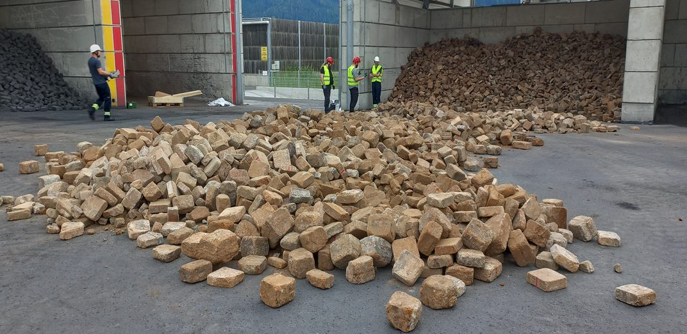The Bulk and the Properties of Interest

The recycling center of RHI Magnesita regularly receives spent refractory bricks from different industries, for example, material from the cement industry’s rotary kilns or the steel industry’s ladles. Both rotary kilns and ladles are lined with different refractory products, which only last a limited time and are then intended to be recycled. Unfortunately, recycling-oriented dismantling, i.e. performing a breakout using the assembly plan and sorting the different refractory products, is not yet established in many companies. Therefore, the received breakout material of kilns and ladles often contains a hodgepodge of refractory products that we would like to separate as well as possible in the future.
Before we can get started with our project, we first have to carry out a representative sampling because we have to be able to represent the bulk, concerning all the properties of interest, in one sample. A representative sampling requires a certain number of random samples with a certain amount of material per random sample. This requirement makes this sampling a rather complex issue. However, it entails the advantage of evaluating the results of future sampling with far less effort, especially regarding consistent data quality. The results of the representative sampling provide a basis on which we can make future decisions.
On July 15, 2022, we performed a representative sampling as part of the first work package of our EU project, “Refractory Sorting Using Revolutionizing Classification Equipment (ReSoURCE)”.
We essentially used three publications as a foundation for our sampling concept: ÖNORM S2127 – “Grundlegende Charakterisierung von Abfallhaufen oder von festen Abfällen aus Behältnissen und Transportfahrzeugen” (Basic characterization of waste heaps or solid waste from containers and transport vehicles), Alexia Aldrian’s dissertation – “Lösungskonzepte für die Probenahme, Probenaufbereitung und Analytik von grobstückigen und heterogenen festen Abfällen” (Proposed solutions for sampling, sample preparation and analysis of coarse and heterogeneous solid wastes) and the Austrian Landfill Ordinance (2008).
Our sampling was probabilistic, i.e. random sampling, and is based on the statistical approach that every property, every grain has the same probability of becoming part of the sample. The prerequisite for this, however, is that the entire quantity of the material to be sampled is accessible. Since the material sampling took place during the ongoing operation of the RHI Magnesita recycling center in Mitterdorf (Austria), this was impossible due to a lack of time, space and personnel. Instead, 10 wheel loader buckets, each with four tons of material, were taken at random points from the entire recycling material to be sampled and spilt on a separate large area. We roughly divided the resulting clusters into grids of 2×2 rectangles depending on the size of the bulk heap. From each of these rectangles, a 25 – 30 kg sample quantity was taken at several randomly selected positions.
We estimated the quantity of the samples by using the following formula from the Austrian Landfill Ordinance (2008):
Quantity of each random sample (kg) = 0.06 x largest grain size (95% percentile) in mm
Without knowing the 95% percentile’s largest grain, it is not possible to calculate the sample quantity using this formula. The 95% percentile indicates which measured values, in our case grain sizes, are smaller than or equal to the measured value of the 95% percentile. Implementing a grain size analysis of such a coarse material is not usual and challenging. You usually would sieve the material, but there are grain sizes of up to 44 cm in our case. Unfortunately, there are no more sieves with which this could be realised. The only option, then, is to measure the stones by hand, which is also something we did during this representative sampling.
So, since the distribution of the grain sizes of the recycling material is not available according to scientific criteria and is also challenging to determine with a grain size of up to 44 cm, we estimated the largest grain to be 44 cm. From a statistical point of view, we are, therefore, on the “safe side” and should have sufficient sample material available for subsequent research experiments.
Altogether, 40 random samples were taken, weighing 25 – 30 kg, i.e. around one ton of material. In the coming weeks, we will present the subsequent sample preparation and analysis methods in separate blog posts.

Author’s Portrait
Karl Friedrich
DI Karl Friedrich is research associate at the Chair of Mineral Processing in the area recycling at the Montanuniversitaet Leoben.
Before that he was employed as research associate at the Chair of Waste Processing Technology and Waste Management (area: sensor-based sorting) and the Chair of Economic and Business Management for sustainability management and digitalization.
Since 2018 he participates in the Montanuniversitaet’s PhD Program. The title of his thesis is “Increasing efficiency in sensor-based sorting processes for polymer waste”.
From 2011 to 2017 Karl studied in the Bachelor and Master program “Energy and Environmental Management” at the University of Applied Sciences Burgenland. His elective subjects were “Environmental process engineering” and “Energy engineering and energy economics” and his master thesis belongs to recycling opportunities for glass residues after thermal waste treatment.
Karl’s research interests are Sensor-based Sorting, Mineral Processing, Recycling, Digitalization, Waste Processing, Waste Management, Life Cycle Assessment and Material Flow Analysis.

Author’s Portrait
Florian Feucht
DI Florian Feucht is research associate at the Chair of Waste Management and Waste Treatment at the Montanuniversität Leoben and part of the Workgroup: “Environmental remediation and mineral waste”. Since 2023, he has been enrolled in the university’s PhD Program. He earned his master’s degree in Applied Geoscience from Montanuniversität Leoben, focusing on the chemical-mineralogical characterization of ladle slag. He completed his bachelor’s degree in Earth Sciences at the University of Vienna, with a thesis on the petrological study of mafic and ultramafic rocks. His research interests include the chemical mineralogical characterization of mineral wastes, mineralogy, slag mineralogy, recycling, and waste management.
Partner

